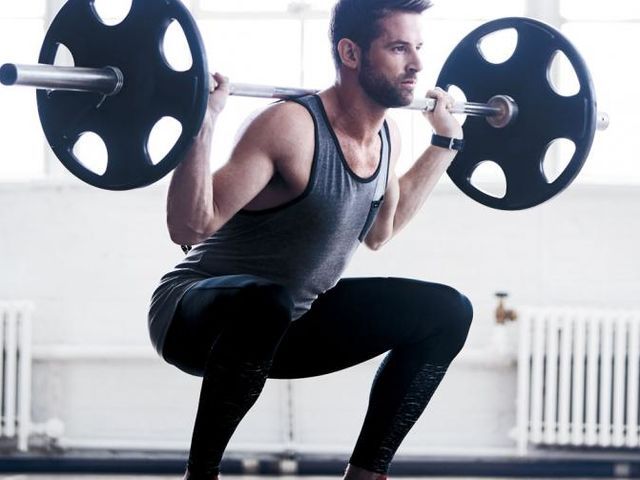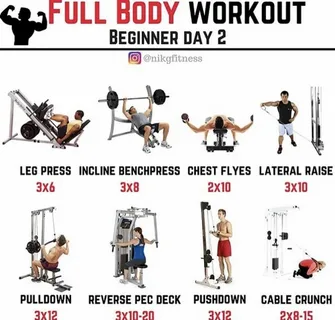The Perfect Full Body Workout Plan for Beginners
Starting a full body workout plan can be an excellent way to improve your fitness, build strength, and increase endurance. A full body workout targets multiple muscle groups, ensuring balanced development and better overall results. For beginners, this approach provides a solid foundation and helps create a routine that is sustainable. This guide will take you through the perfect full body workout plan for beginners, focusing on exercises that are simple yet effective.
- Why Full Body Workouts Are Ideal for Beginners

A full body workout is particularly suitable for beginners because it allows you to engage all major muscle groups in a single session. This method provides an efficient and balanced workout that promotes muscle growth and strength without overworking any specific area. Additionally, full body workouts are ideal for those new to fitness as they help improve muscle coordination, flexibility, and overall fitness levels. It’s also easier to stick to since you don’t need to spend multiple days in the gym targeting individual muscles.
- Key Principles of a Beginner’s Full Body Workout Plan
When starting a full body workout plan, it’s essential to keep a few key principles in mind. First, focus on compound movements that work several muscles at once, such as squats, lunges, and push-ups. These exercises are efficient and effective for building strength. Second, aim for proper form to prevent injuries and maximize results. Finally, start with lighter weights and gradually increase them as you build strength and confidence in your workouts. Consistency and gradual progression are key to seeing results from your full body workout.
- Warm-Up: Preparing Your Body for the Workout
Before diving into your full body workout, it’s essential to warm up properly. Warming up increases blood flow to your muscles and reduces the risk of injury. A good warm-up should last about 5-10 minutes and include dynamic stretches or light cardio, such as jogging or jumping jacks. Dynamic stretching helps loosen up your muscles and improve your range of motion. This step is vital for preparing your body for the intensity of the workout and ensuring that you perform exercises safely and effectively.
- Squats: Building Lower Body Strength
Squats are a fundamental exercise in any full body workout plan. They target the quadriceps, hamstrings, glutes, and core, making them a powerful movement for building lower body strength. For beginners, start with bodyweight squats to get the hang of the movement before adding resistance, such as dumbbells or a barbell. To perform a squat, stand with your feet shoulder-width apart, lower your body as if sitting in a chair, and keep your chest upright. Focus on engaging your core and pushing through your heels as you rise back up.
- Push-Ups: Strengthening the Upper Body
Push-ups are a classic upper body exercise that targets the chest, shoulders, triceps, and core. For beginners, push-ups can be modified by performing them on your knees or against a wall until you build enough strength to perform them with proper form. Begin in a plank position, with your hands slightly wider than shoulder-width apart, and lower your body until your chest almost touches the floor. Push back up to the starting position, keeping your core tight and your body in a straight line throughout the movement.
- Bent-Over Rows: Developing Back and Core Muscles
Bent-over rows are an excellent exercise for developing your back, shoulders, and core muscles. This movement is particularly beneficial for improving posture and preventing back pain. To perform a bent-over row, hold a dumbbell or barbell with both hands, hinge at your hips, and keep your back flat. Pull the weight towards your chest, squeezing your shoulder blades together at the top of the movement. Lower the weight back down slowly, ensuring that your core remains engaged throughout the exercise.
- Plank: Enhancing Core Stability
The plank is a simple yet effective exercise for strengthening your core muscles. It helps improve stability, balance, and overall core strength. To perform a plank, start in a forearm or high plank position with your body in a straight line from head to heels. Engage your core, glutes, and legs, and hold the position for as long as you can while maintaining proper form. Planks are an essential part of a full body workout plan because a strong core is crucial for overall strength and injury prevention.
- Lunges: Toning the Lower Body
Lunges are another excellent lower body exercise that targets the quads, hamstrings, glutes, and calves. Lunges also help improve balance and coordination. To perform a lunge, step forward with one foot and lower your body until both knees are bent at a 90-degree angle. Push through your front heel to return to the starting position and repeat on the other leg. You can perform lunges with or without weights, depending on your fitness level. This exercise can be done stationary or walking, both of which are effective for toning the lower body.
- Cool-Down: Stretching and Recovery
After completing your full body workout, it’s crucial to cool down and stretch. Cooling down helps bring your heart rate back to normal and prevents muscle stiffness. Spend about 5-10 minutes performing static stretches that target the muscles you’ve worked during your session. Focus on stretching your quads, hamstrings, chest, back, and shoulders. Cooling down also aids in muscle recovery, which is essential for preventing soreness and ensuring that you can continue your workout routine consistently.
- Structuring Your Workout Routine
As a beginner, it’s important to structure your full body workout routine in a way that allows your muscles to recover while still providing enough challenge to promote growth. Aim for 2-3 full body workout sessions per week, with at least one rest day in between. Each session should last around 45-60 minutes, including warm-up and cool-down. As you progress, you can start incorporating additional exercises or increasing the intensity of your workouts by adding more weight or performing more repetitions.
Conclusion
Starting a full body workout plan is an excellent way for beginners to build strength, improve fitness, and develop healthy habits. By focusing on compound movements like squats, push-ups, lunges, and bent-over rows, you can engage multiple muscle groups and achieve balanced results. Remember to warm up properly, focus on proper form, and allow for adequate recovery between workouts. As you gain experience and confidence, you can gradually increase the intensity of your workouts to continue progressing towards your fitness goals. Consistency, patience, and dedication will lead to long-term success in your fitness journey.



